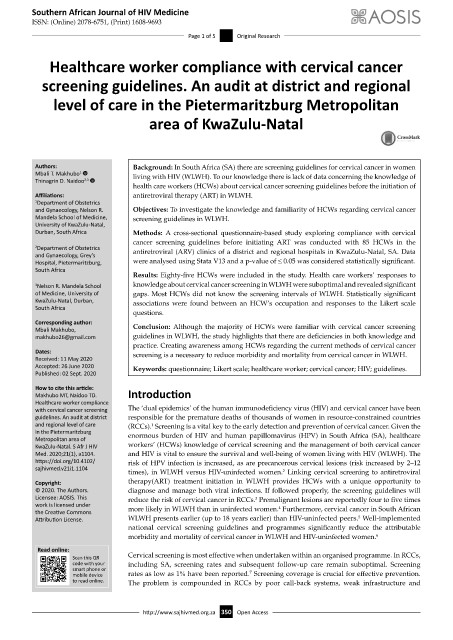Page 358 - HIVMED_v21_i1.indb
P. 358
Southern African Journal of HIV Medicine
ISSN: (Online) 2078-6751, (Print) 1608-9693
Page 1 of 5 Original Research
Healthcare worker compliance with cervical cancer
screening guidelines. An audit at district and regional
level of care in the Pietermaritzburg Metropolitan
area of KwaZulu-Natal
Authors: Background: In South Africa (SA) there are screening guidelines for cervical cancer in women
Mbali T. Makhubo 1 living with HIV (WLWH). To our knowledge there is lack of data concerning the knowledge of
Thinagrin D. Naidoo
2,3
health care workers (HCWs) about cervical cancer screening guidelines before the initiation of
Affiliations: antiretroviral therapy (ART) in WLWH.
1 Department of Obstetrics
and Gynaecology, Nelson R. Objectives: To investigate the knowledge and familiarity of HCWs regarding cervical cancer
Mandela School of Medicine, screening guidelines in WLWH.
University of KwaZulu-Natal,
Durban, South Africa Methods: A cross-sectional questionnaire-based study exploring compliance with cervical
cancer screening guidelines before initiating ART was conducted with 85 HCWs in the
2 Department of Obstetrics
and Gynaecology, Grey’s antiretroviral (ARV) clinics of a district and regional hospitals in KwaZulu-Natal, SA. Data
Hospital, Pietermaritzburg, were analysed using Stata V13 and a p-value of ≤ 0.05 was considered statistically significant.
South Africa
Results: Eighty-five HCWs were included in the study. Health care workers’ responses to
3 Nelson R. Mandela School knowledge about cervical cancer screening in WLWH were suboptimal and revealed significant
of Medicine, University of gaps. Most HCWs did not know the screening intervals of WLWH. Statistically significant
KwaZulu-Natal, Durban, associations were found between an HCW’s occupation and responses to the Likert scale
South Africa
questions.
Corresponding author: Conclusion: Although the majority of HCWs were familiar with cervical cancer screening
Mbali Makhubo,
[email protected] guidelines in WLWH, the study highlights that there are deficiencies in both knowledge and
practice. Creating awareness among HCWs regarding the current methods of cervical cancer
Dates: screening is a necessary to reduce morbidity and mortality from cervical cancer in WLWH.
Received: 11 May 2020
Accepted: 26 June 2020 Keywords: questionnaire; Likert scale; healthcare worker; cervical cancer; HIV; guidelines.
Published: 02 Sept. 2020
How to cite this article:
Makhubo MT, Naidoo TD. Introduction
Healthcare worker compliance
with cervical cancer screening The ‘dual epidemics’ of the human immunodeficiency virus (HIV) and cervical cancer have been
guidelines. An audit at district responsible for the premature deaths of thousands of women in resource-constrained countries
and regional level of care (RCCs). Screening is a vital key to the early detection and prevention of cervical cancer. Given the
1
in the Pietermaritzburg enormous burden of HIV and human papillomavirus (HPV) in South Africa (SA), healthcare
Metropolitan area of
KwaZulu-Natal. S Afr J HIV workers’ (HCWs) knowledge of cervical screening and the management of both cervical cancer
Med. 2020;21(1), a1104. and HIV is vital to ensure the survival and well-being of women living with HIV (WLWH). The
https://doi.org/10.4102/ risk of HPV infection is increased, as are precancerous cervical lesions (risk increased by 2–12
sajhivmed.v21i1.1104
times), in WLWH versus HIV-uninfected women. Linking cervical screening to antiretroviral
2
Copyright: therapy(ART) treatment initiation in WLWH provides HCWs with a unique opportunity to
© 2020. The Authors. diagnose and manage both viral infections. If followed properly, the screening guidelines will
Licensee: AOSIS. This reduce the risk of cervical cancer in RCCs. Premalignant lesions are reportedly four to five times
3
work is licensed under 4
the Creative Commons more likely in WLWH than in uninfected women. Furthermore, cervical cancer in South African
5
Attribution License. WLWH presents earlier (up to 18 years earlier) than HIV-uninfected peers. Well-implemented
national cervical screening guidelines and programmes significantly reduce the attributable
morbidity and mortality of cervical cancer in WLWH and HIV-uninfected women. 6
Read online:
Read online:
Scan this QR
Scan this QR Cervical screening is most effective when undertaken within an organised programme. In RCCs,
code with your including SA, screening rates and subsequent follow-up care remain suboptimal. Screening
code with your
smart phone or 7
smart phone or
mobile device
mobile device rates as low as 1% have been reported. Screening coverage is crucial for effective prevention.
to read online.
to read online. The problem is compounded in RCCs by poor call-back systems, weak infrastructure and
http://www.sajhivmed.org.za 350 Open Access

